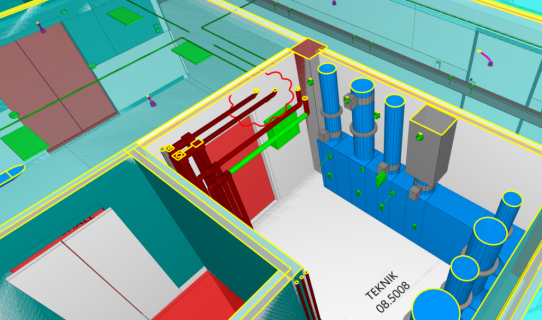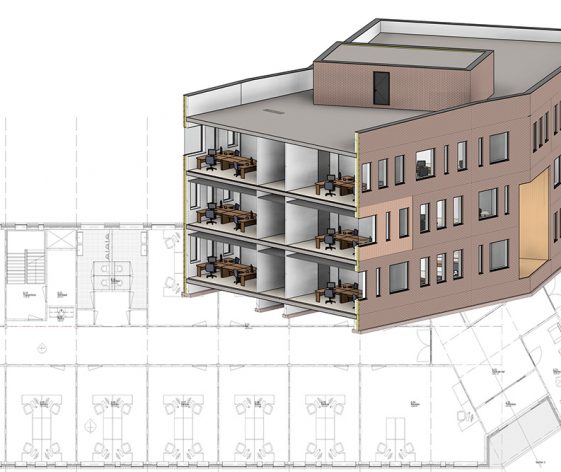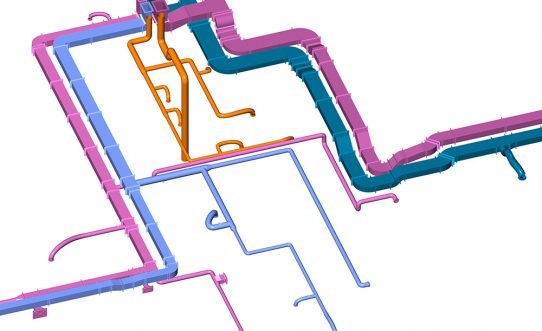Digital project solutions
Utilize the Project Information Model (PIM) to your advantage, whether you’re a project manager or contractor, to advance model development. Leveraging the model as an information conduit on the construction site can be immensely valuable. Swiftly extracting 3D geometries or accessing data from information-rich models can aid in various tasks and planning activities, both before and during construction. This not only enhances project efficiency but also minimizes errors and rework. Moreover, it fosters improved communication and coordination among project stakeholders.
Our services, outlined below, aim to avoid analogues work and optimize your daily operations, allowing you to capitalize on valuable opportunities that result in significant time savings.
The scope of capabilities:
- Design reviews & visualization
- Model coordination
- Quality assurance & clash control
- BOQ (Bills of quantity)
- Schedule planning
- Cost management
- Integrated time and cost control
- LCA-analysis | climate estimations
- Digital logistics & supply chain management
Model coordination
Facilitate coordination among project model disciplines, to ensure effective collaboration and communication within the project. The outcome of an 3D environment with efficiency of the whole scope of the facility would increase quality and better project understanding. Early detection and resolution of clashes and conflicts within the 3D model are essential in preventing issues and errors at the construction site, reducing misunderstanding, minimizing rework and cost overruns.

2D & 3D interaction
The combination of 2D with 3D visualization offers the owner a clearer understanding and illuminates the construction process before it is executed, facilitating more informed and dependable decision-making. We consistently advocate for the use of both combinations, without dismissing the value of 2D drawings in their digital form.

Supply with productivity on construction site
General contractors (GCs) and their subcontractors can proactively plan their project site setup, construction safety measures, and logistics in the early stages through 3D visualization. The model geometries offer a fresh perspective on cost and time management. Additionally, it enables efficient procurement of building materials connected to various elements in the BIM model.
Model-based time and cost control
– Using BIM models, construction professionals can make detailed time schedules showing the lead time, progress, and interdependencies between different work tasks. Moreover, they can optimize the use of space on the construction site and visualize how the project will progress over time.
– The term 5D BIM adds cost data to the BIM model. Each component in the BIM model is associated with cost data, e.g. purchase cost, running cost and renewal cost. By multiplying the quantity of each component type with the cost of each component, the BIM model can calculate the total project cost. In the planning and design phases, 5D may assist construction professionals in producing more accurate cost estimates and assessing how potential changes may impact cost.
Green BIM assessments
Climate declaration for new construction projects in Sweden is mandatory since January 1st, 2022. This means that owners/developers must report the impact from an environmental aspect to building committee to get approval before project final.
The key to minimizing a building’s environmental footprint lies predominantly in the initial planning and design phase, where a variety of designs, solutions, and techniques are explored. Early engagement with climate assessments and the development of a climate declaration, such as performing a climate estimation, facilitates the acquisition of essential data for later stages.

Retain environmental changes with life cycle sustainability
The BIM model could also provide sustainable possibilities to manage a facility from an environmental standpoint. Utilize the model geometry and asset data to generate visual Life Cycle Analyses (LCAs) and continuously monitor energy usage and carbon CO2 emissions over the years ahead.
We will assist you with model-based calculation method that is based on a high degree of automation and discovering ways to minimize your environmental footprints with traceable and fast trade deviation that outcomes visually.

Automated verification procedures
The size and complexity of a project could lead to massive design conflicts and data management that is time consuming to track down. The validation process is a critical step to assess the performance and reliability of a BIM model, to ensure desired project demands and criteria.
Our mantra at BIMextract is to add workflows with creativity and automated processes that expedite error identification, accomplish faster deviation outcomes and quality assurance of the design.

